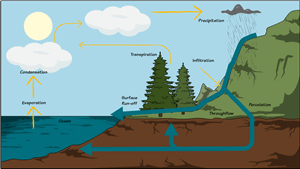Student Activities for Water Cycle
Essential Questions for the Water Cycle
- Where does rain come from?
- What causes rivers to flow?
- Why is rain not salty?
- What are the major steps in the Water Cycle?
The Water Cycle Explained
The water cycle has no starting point, but because the ocean contains the most water, many cycles often use the ocean as a starting point. The ocean covers 76.5% of the Earth’s surface and so absorbs a huge amount of the Sun's energy. As the ocean absorbs the energy, it heats up. Some of this energy causes the water to evaporate. This warm, moist water is less dense than the cooler air around it. This less dense air rises, and as it rises, it cools. This water then condenses to form clouds. Water forms larger droplets and will fall back down to earth due to gravity. What state it falls to earth as depends on the temperature.
If it is really cold, the precipitation will fall as snow, frozen rain, or hail, but if it is warmer, it will fall as rain. Some precipitation falls back into bodies of water and the rest falls onto land. Some that falls as snow can build up as icecaps and glaciers; this water can stay frozen for thousands of years. Some of the water that hits the ground runs into rivers. This is called surface runoff. Some water may flow into lakes while some will flow into rivers and then ultimately back into the ocean. Other water infiltrates the ground and travels underwater. Some of it is stored underground and some of this water flows back into the ocean.
The water cycle also plays a vital role in the survival of plants, as they need water to survive. Most plants need water in their leaves, the location where photosynthesis mainly takes place. In order to move this water, the plant uses small tubes in the plant's stem called xylem. The plant uses a process called transpiration to move water. Transpiration is the process where water on the plants evaporates. Temperature, humidity, light, and wind speed can all affect the rate of transpiration. Some of the water is stored in the plant and is released when the plant tissues decompose.
Not every country has a clean plentiful supply of water. Some countries don’t have a lot of rainfall due to their location. Talk with your students about the environmental and social issues surrounding water around the world.
Additional Water Cycle Activity Ideas
- Compare how water cycles differ in different parts of the world using a T-Chart.
- Make a storyboard to describe what the world would be like if the water cycle didn’t exist.
- Have your students make a poster to encourage people to reduce the amount of water they use.
© 2024 - Clever Prototypes, LLC - All rights reserved.
StoryboardThat is a trademark of Clever Prototypes, LLC, and Registered in U.S. Patent and Trademark Office






